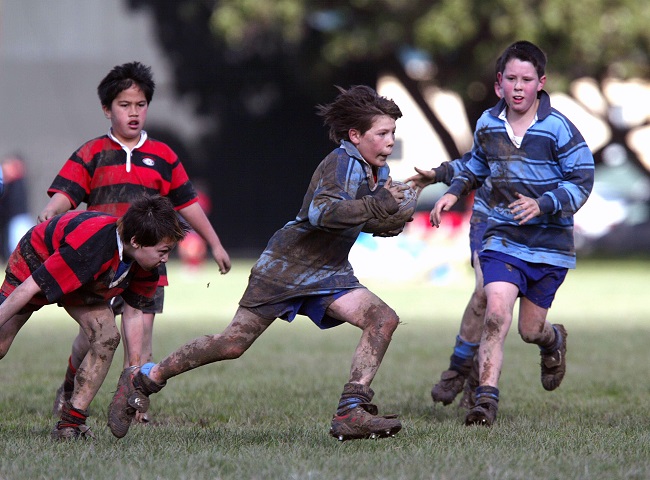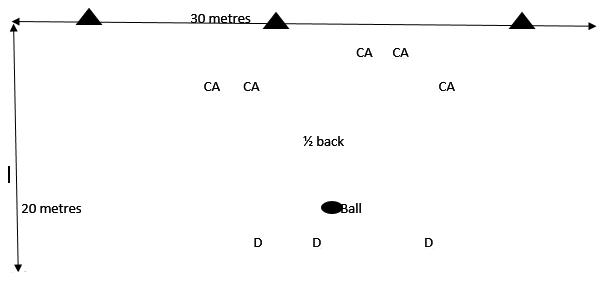- Rugby Toolbox
- Resources & Education
- Learn more
- Articles
- Snook on Coaching
- Under 13 – The Counter Attack
- Ruck & Run Drill
- Playing Philosophy – Ruck & Run Coaching Components
- Playing Philosophy – Spread the Forwards
- Playing Philosophy – A forward behind the ruck
- Playing Philosophy – Ruck & Run
- Playing Philosophy – An idea!
- The Breakdown
- Building Positivity [3]
- Building Positivity [2]
- Building Positivity
- Fitness and Game Related Activities
- Getting the Head Working
- Missiles are Dangerous
- Use of Video
- Winger Attacking Outside First-Five
- Player Profiling
- Selection
- Fitness Away from the Team Session
- Playing Philosophy (Pre season Prep)
- Coaching the Coaches
- The Rugby Coordinator and Pre-Season Preparation
- Why Not Use Tap Penalties More Often?
- Why Kick the Ball Down the Middle of the Field?
- Defending the 5 Metre Lineout Drive
- Scoring from the 5 Metre Lineout
- What are the Kicking Team Aiming to Achieve from Halfway Restart
- Should We Practice Scoring Tries?
- Team Culture
- Looking After Your Players
- Coach Survival Tips
- Under 11/13 – Backline Defence
- Under 11/13 – Ruck Defence
- Under 11/13 – Back Attack
- Under 13 – The Counter Attack
- Under 11/13 – The Maul
- Under 11/13 – Lineouts
- Under 11/13 – Decision Making
- Under 11/13 – Support Play
- Under 11/13 – Dive Pass and More
- Under 11/13 – Drop & Grubber Kick /Highball Catch
- Under 11/13 – Front on Tackling
- Under 11/13 – Contact – Getting Up – The Ruck
- Under 11/13 – The Coaching Session
- Under 8/10 – Using Space
- Under 8/10 – Kicking
- Under 8/10 – Contact and Picking Up the Ball
- U8/U10 Draw & Pass and Sidestep
- Under 8/10 – The Tackle
- Under 8/10 – The Coaching Session
- Under 7 – Test Your Coaching – Support Play
- Tap Pass and Swerve U7
- Ball Familiarisation; Passing & Receiving
- Activities for the Non-Contact Tackle
- Under 7 – The Coaching Session
- Coaching Teenagers – After the Ruck
- Coaching Teenagers – The Practice Session
- Coaching Teenagers – Best Practice
- Coaching Kids – Best Practice
- Plays from a Tap Penalty
- Running Plays from a 5 Man Lineout
- Driving Plays from a 5 Man Lineout
- Strike Plays at the End of the Lineout
- Back Strike Plays at the Lineout
- Wide Strike at the Scrum (2)
- Wide Strike at the Scrum
- Midfield Attack at the Scrum
- No 8 Plays at the Scrum (2)
- No 8 Plays at the Scrum
- The Cut Out Pass
- Skills to Penetrate (2)
- Skills to Penetrate
- Movements to Penetrate
- Patterns to Penetrate
- Contact and Continuity
- Keeping the Ball Alive Out Wide
- Pre Season Support Activities
- Checklist
- Understanding the game
- The Playing Philosophy
- The Lineout
- Overview
- Team Profile
- Start Now!
- Backrow
- Nine and Ten
- Rugby-related Fitness Activities
- The Psychological Edge
- Open Field Play
- Key Performance Indicators
- Improving Team Performance
- Backline Attack Concepts
- Tactics at Phase Play
- Playing Philosophy
- The ‘Stop Focus’
- Kick Attack
- Clearing the 22
- Wide Attack at Phase
- Player Focus
- Scrum Preparation
- Lineout Preparation
- Back Attack Preparation
- Sevens Preparation
- Sevens Kick Offs
- Sevens Scrum and Lineout
- Sevens Attack Patterns
- Sevens Defence
- 7's Selection and Game Planning
- Coaching and Leadership
- How the Game Evolves
- Changing Within the Game
- Learning from the Television.
- Using Tap Penalties Wisely
- Defence Drills
- Defence Drills for Tight Five
- Team Defence and TUB’ing
- Establishing Patterns from the Ruck
- Structured Phase Play
- Structuring Phase Play on the Run
- Coaching Roles
- Structuring a Close in Tackling/Defensive Session
- Coaching in Threes
- Attacking Back Play
- Kick Off Chase
- Wrap Around Back Plays
- Lineout Plans
- Looking and Learning
- Motivating Your Players
- Scrum Attack
- Refocusing the Team
- Monitoring the Progress
- Learning the Game
- Playing to the Laws
- Small is OK
- Decisions After the Tackle
- Improving Your Coaching
- Food for Thought
- More Food for Thought
- Passing & Catching
- How Ireland Nearly Beat the All Blacks
- The Progressive Coach
- Try Something New
- Encouraging Excitement
- The Mental Approach
- Where to Start
- Being the Best You Can Be
- Off the Ball Decisions
- Lineouts Difficult to Master
- Decisions on the Run
- Rucking and Rolling
- A Successful Approach
- Gaining Clarity
- Manipulation vs Physicality
- Beating the Drift
- To Ruck or Not to Ruck
- Stopping the Lineout Drive
- Fine Tuning the Planning
- It's a Running Game
- RugbySmart 2015
- Using the Shoulders
- Loosehead Prop / Tighthead Prop
- Position Specific – Hooker
- Position Specific – Lock
- Position Specific – Blindside Flanker
- Position Specific – Openside Flanker
- Position Specific – No 8
- Position Specific – Halfback
- Position Specific – First Five Eighth
- Position Specific – Second Five Eighth
- Position Specific – Centre Three-quarter
- Position Specific – Wing
- Position Specific – Fullback
Under 13 – The Counter Attack

To counter attack is to attack with the ball that the team has regained from broken play or from a kick by the opposition.
It is an exciting aspect of the game and should be encouraged when the opportunity arises.
Key Factors
- Recognising the opportunity. The player receiving the ball must quickly establish if they have sufficient time and space to begin an attacking movement or whether support is on hand to clear the ball from the pressure area to begin a passing/running attack.
- The player must look – think – decide – act all in a short period.

- Support players communicating will help.
- Questions: Is there space? Are there support players close by? Is there time to run at the defenders before passing away from the pressure? Does it require passing in to space and outflanking the defenders (requires plenty of support players getting back)
- Ensuring that you run to support
- Communicating with verbal and physical cues.
ACTIVITIES
Make up a ‘rule of thumb’ for the team to follow:
- Two big passes: pass in to space to clear the oncoming defensive line and support hard out
- Run towards the opposition and then attack the space you have just left. Run the ‘whip handle’ – as you run towards the defence a line of attackers head off in the other direction and the ball carrier scissor passes with the handle of the whip (closest player)
- Double around. Make a pass and double around the player passed to. Support links up.
Make up your own rules.
SCENARIOS
Situations will arise from spilled ball, loose ball and ball kicked through.
1-Start with small numbers and kick a ball through or roll a ball in amongst a group.
The team regaining possession must run, pass, double around and support to carry the ball forward.
Start with 4 v 2 inside a 20 metre grid; then a 4 v 3; 5 v 3 etc.
Coach as the activity is carried out.
2- The spilled and loose ball situation will often occur in a contact zone with quite a few players near.
If this is the case then practice the ‘two big passes’ rule. The player who regains possession will make a quick pass out of the pressure situation and the receiver who should have more time will stay in balance and make a long pass to a teammate who is away from the contact zone and has time and space to mount an attack. The support players need to get there as soon as possible.
Set up activities with the attack having superior numbers.
In an area inside the 22 with 10 attackers and 6/7 defenders (or similar) a player is tackled and loses the ball. Both teams have players close to the tackle zone.
The team regaining possession will recover the ball and apply the two-pass rule. The idea will be to score each time. They must quickly regroup and outflank the defence who are also regrouping.
Keep practicing this type of activity and increase the difficulty with a couple more defenders.
Running a line to threaten, using decoys and scissors, and ensuring plenty of players are supporting more than once will be important.
3- Counter attacking from a kick can apply the ‘running towards the opposition’ rule or heading straight in to space and applying the ‘double around’ rule.
Set up scenarios using half a field with the team with fewer players kicking the ball to the opposition and making a concerted chase.
The receiver will decide whether they should run back at the zone where most of the players are situated so as to set up the ‘whip handle’, or attack out wide because very few defenders are in place. Go fast and double around will be their thinking.
Activities
5 v 3

Kicker kicks in to space / A’s (attackers) chase after the kick / CA’s (Counter Attackers) make a decision based on where the ball has landed etc. / CA group need to reform and choose the best plan. / area could be a quarter of the field or start smaller and closer together as you coach the methods and skills.
Plan: (for CA’s) Get the ball – hold the attackers – get the ball in to open spaces – penetrate and support – score!
Using Turnover Ball under pressure
4 v 2 / 5 v 3 / 6 v 4

Roll the ball to any spot inside the grid / the ½ back will go to the ball and wait / the CA’s (Counter Attackers) will run around a cone and form up for a counter attack / the defenders will stay a metre back but get organised early based on what they see happening / the attack aim is to score each time.
The two big passes rule could apply with wrapping and supporting or the players could all line up on one side and then as a group use the whip handle. Initially just quick passing and threatening should do the trick.
These are the very basics of counter attack but are a good starting point. As the players improve they will start to recognise other opportunities based on where most of their team are situated, whether a situation can be set up with backs running against forwards or even attacking back down the short side as most defenders have already started to drift across the field anticipating a wide attack.
Watch what happens on the television and see if you can design some activities that will suit your kids.